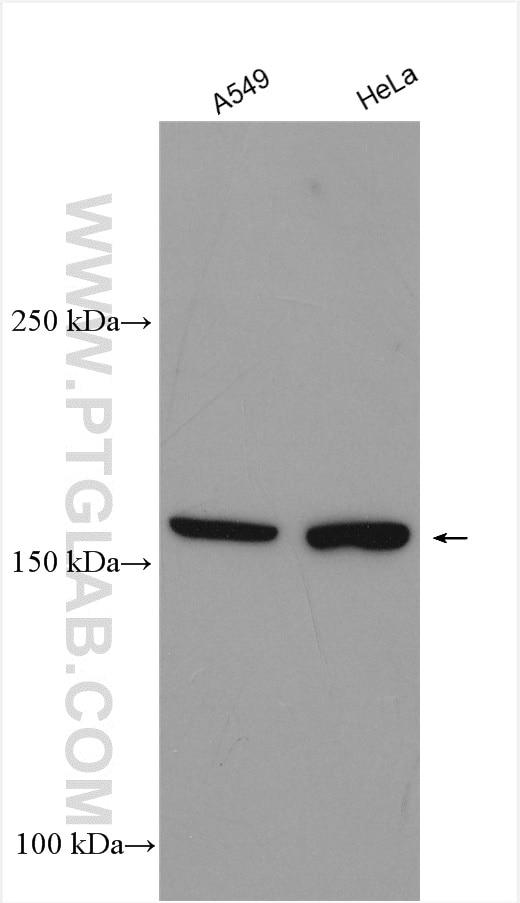Anticorps Polyclonal de lapin anti-JMJD3
JMJD3 Polyclonal Antibody for WB, ELISA
Hôte / Isotype
Lapin / IgG
Réactivité testée
Humain et plus (2)
Applications
WB, ELISA
Conjugaison
Non conjugué
N° de cat : 55354-1-AP
Synonymes
Galerie de données de validation
Applications testées
| Résultats positifs en WB | cellules A549, cellules HeLa |
Dilution recommandée
| Application | Dilution |
|---|---|
| Western Blot (WB) | WB : 1:500-1:2400 |
| It is recommended that this reagent should be titrated in each testing system to obtain optimal results. | |
| Sample-dependent, check data in validation data gallery | |
Applications publiées
| WB | See 8 publications below |
Informations sur le produit
55354-1-AP cible JMJD3 dans les applications de WB, ELISA et montre une réactivité avec des échantillons Humain
| Réactivité | Humain |
| Réactivité citée | rat, Humain, souris |
| Hôte / Isotype | Lapin / IgG |
| Clonalité | Polyclonal |
| Type | Anticorps |
| Immunogène | Peptide |
| Nom complet | jumonji domain containing 3, histone lysine demethylase |
| Masse moléculaire calculée | 177 kDa |
| Poids moléculaire observé | 177 kDa |
| Numéro d’acquisition GenBank | NM_001080424 |
| Symbole du gène | JMJD3 |
| Identification du gène (NCBI) | 23135 |
| Conjugaison | Non conjugué |
| Forme | Liquide |
| Méthode de purification | Purification par affinité contre l'antigène |
| Tampon de stockage | PBS with 0.02% sodium azide and 50% glycerol |
| Conditions de stockage | Stocker à -20°C. Stable pendant un an après l'expédition. L'aliquotage n'est pas nécessaire pour le stockage à -20oC Les 20ul contiennent 0,1% de BSA. |
Informations générales
JMJD3, also known as KDM6B, is a 1643 amino acid protein, which belongs to the UTX family. JMJD3 is a Histone demethylase that specifically demethylates 'Lys-27' of histone H3, thereby playing a central role in histone code (PubMed:17825402, PubMed:17851529, ). JMJD3 demethylates trimethylated and dimethylated H3 'Lys-27', so it Plays a central role in regulation of posterior development, by regulating HOX gene expression (PubMed:17851529). Histone demethylases are epigenetic actors with a crucial role in cancer by acting as suppressors of tumors or as oncogenes. JMJD3 and UTX (ubiquitously transcribed tetratricopeptide repeat, X chromosome) are transcription activators, being specific H3K27me3 demethylases. JMJD3 is involved in many cellular process such as development, differentiation, senescence and aging by p16, p53 and RB pathways and finally inflammation. Depending on cancer type, JMJD3 expression is increased (prostate and breast cancers, melanoma, gliomas, renal cell carcinoma or decreased (lung, liver, pancreatic, colon and colorectal cancers. This role in carcinogenesis has allowed the development of "epidrugs" to modulate JMJD3 expression (PMID: 29805743 ).
Protocole
| Product Specific Protocols | |
|---|---|
| WB protocol for JMJD3 antibody 55354-1-AP | Download protocol |
| Standard Protocols | |
|---|---|
| Click here to view our Standard Protocols |
Publications
| Species | Application | Title |
|---|---|---|
Inflammation Glycoprotein Nonmetastatic Melanoma Protein B (GPNMB) Ameliorates the Inflammatory Response in Periodontal Disease. | ||
Gene miR-148a-3p regulates adipocyte and osteoblast differentiation by targeting lysine-specific demethylase 6b. | ||
Stem Cells Dev Inhibition of Ezh2 In Vitro and the Decline of Ezh2 in Developing Midbrain Promote Dopaminergic Neurons Differentiation Through Modifying H3K27me3. | ||
Oncol Rep Targeting P16INK4A in uterine serous carcinoma through inhibition of histone demethylation. | ||
Nat Cardiovasc Res α-Ketoglutarate promotes cardiomyocyte proliferation and heart regeneration after myocardial infarction |


